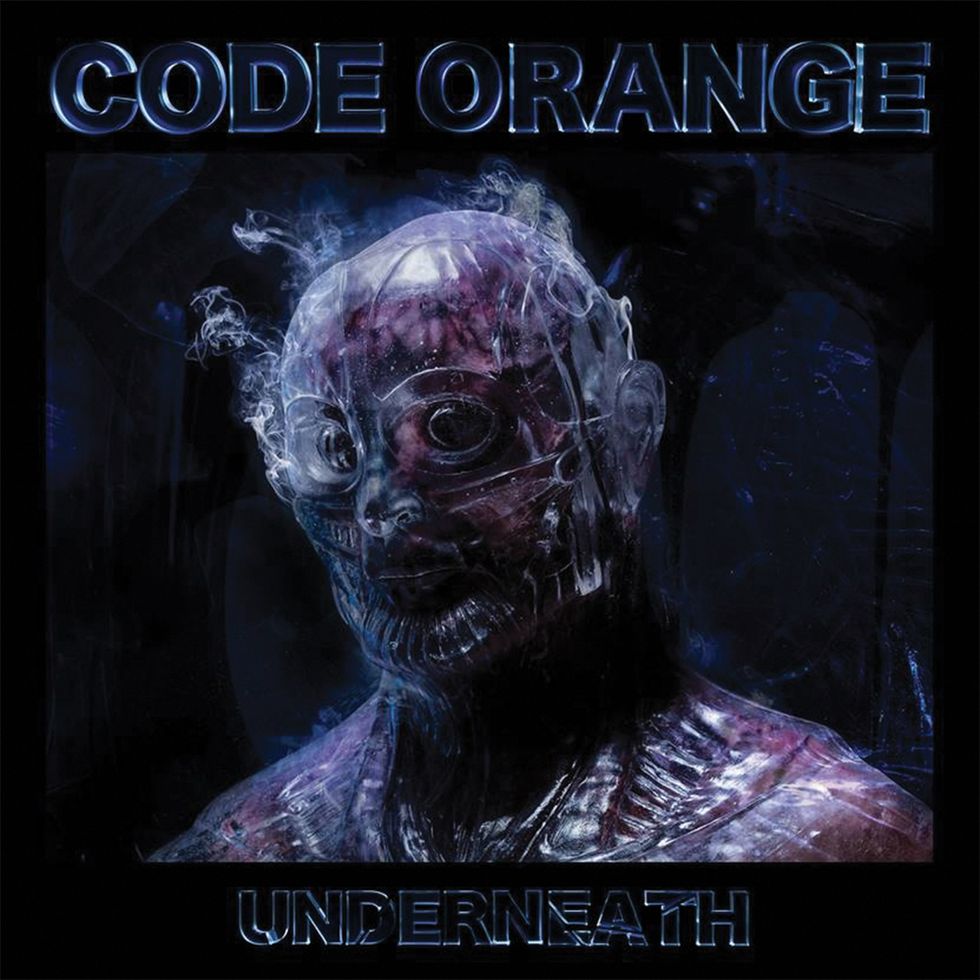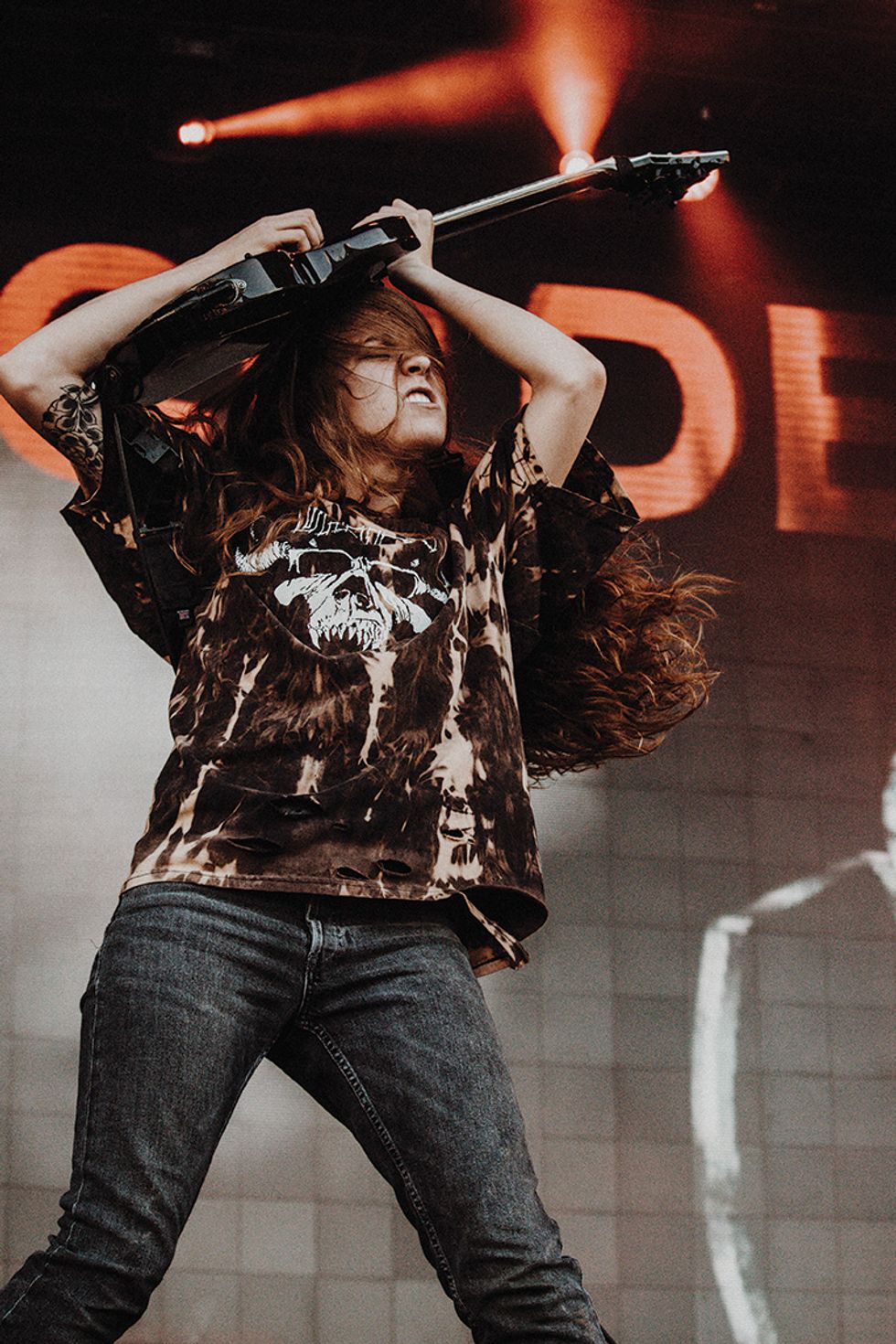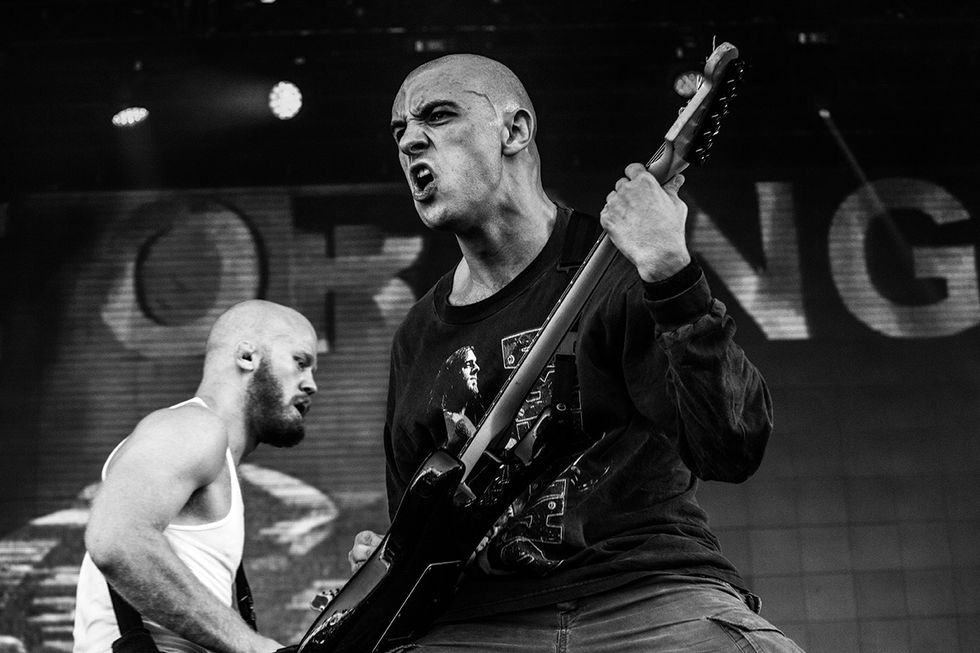For all of the sonic evolution and cross-pollination hardcore has experienced since splintering from the punk-rock tree in the 1980s, it’s also a deeply reverent subculture that values its history immensely—often to the point of the myopic pursuit of its past. Bands crop up with each generation that are equally championed and criticized for how accurately they bite into the sounds of yesteryear, and while that phenomenon is embraced almost as something akin to oral tradition, it rarely births breakout artists.
Code Orange are an exception. With their new album, Underneath, the band has struck a unique balance between honoring its hardcore roots, developing a grand artistic vision, and crafting an unexpected approach to writing and recording that makes for a stunningly unique work that transcends genre and, in many ways, represents a step forward for heavy music. At minimum, Underneath is a tremendous leap for a band that’s grown immensely over 12 years, from metalcore-niche darlings to fearless mavericks taken very seriously for their work.
Underneath’s predecessor, 2017’s Forever, was their third album and earned Code Orange a Grammy nomination and near-universal praise. It was an evolution in every way for the Pittsburgh-bred crew. That album explored the fusion of industrial and electronic elements, along with the band’s well-honed, vicious take on metallic hardcore. Underneath takes that formula to its outer limits, also mining the ore of ’90s alt-metal and industrial music and twisting it all into new forms through digital manipulation and sampling techniques. It’s a sonic cyborg that retains the humanity of a hardcore band while grafting electronic-music techniques to itself in a cutting-edge way.
Remarkably, Underneath shirks the goofiness and gimmicky nature that’s plagued so many past marriages of electronics and guitar-based heavy music. Despite the ambitious production, guitar remains the blood pumping through the album’s machine heart, and the bandmembers responsible for the absurdly heavy riffs and layered 6-string textures are Reba Meyers and Dominic Landolina. They come from distinctly different places in aggressive music, but provide a perfect complement for each other within Code Orange’s cold-metal terrain. Meyers developed her skills in the punk-hardcore world, and Landolina’s playing was informed by classic thrash- and death-metal, but these riffsmiths share a knack for writing rhythmically focused haymakers that are bludgeoning, tricky, and somehow catchy.
On Underneath, Meyers and Landolina made fully realized demos and passed them to the band’s electronics wiz (and occasional guitarist), Eric “Shade” Balderose, who manipulated, tweaked, and added. Riffs were modified, sampled, chopped, and glitched to reimagine each idea before the guitarists were tasked with the unenviable work of reverse-engineering the tracks and finding ways to bring this cybernetic metalcore into the live realm. (The band also includes vocalist and drummer Jami Morgan and bassist Joe Goldman.)
Throughout all of this, the goal was to keep the human element vital and present and erase the lines between digital and organic. This meant employing both fire-breathing tube amps and digital amp sims, and old-school pedals and plug-ins. When the time came to turn their demos into the ultimate Frankenstein’s monster, Code Orange worked with mega-producer Nick Raskulinecz (Foo Fighters, Mastodon, Deftones), with additional programming by an original architect of the ’90s industrial revolution, Chris Vrenna (Nine Inch Nails, Marilyn Manson). Will Yip also served as co-producer.
As the COVID-19 pandemic stopped the world, cancelling tours and shows everywhere, Code Orange made the call to play its Underneath release gig another way: livestreaming what looked like a full-production concert film from an empty venue in their hometown. The catharsis of the show footage is incredibly moving and makes clear what a monumental effort was involved in creating Underneath.
Premier Guitar spoke with Meyers and Landolina by phoneto get the inside story on building Underneath’s turbulent realm, the artists and albums of heavy music’s recent past that inspired its songs and their worlds as players, and the tools and techniques required to musically graft man and machine.
Forever got a Grammy nomination and established the band beyond the metal and hardcore world. Did that change how you approached Underneath and add to its grander vision?
Reba Meyers: If it did, it was subconscious. With all the attention and people recognizing what we honestly already knew in our hearts we could achieve, it simply cemented our resolve when writing this record. We took the attention as motivation that we really can reach as far as we’d imagined, and we cracked the fuck down and wouldn’t take “no” for an answer on things or compromise.

TIDBIT: Meyers and Landolina did much of this album’s guitar tracking on their own DAWs, with digital manipulation by Balderose. The results are delirious guitar riffs like those on “Cold.Metal.Place” and “Swallowing the Rabbit Whole.”
A lot of times on our past records, we would hit a point where we just couldn’t get it any better, and we didn’t know how to. We took as much of it into our own hands that we could—writing, recording, mixing, mastering—and it drove us crazy, but we knew if we really did this record how we imagined it, it could become something that we’re extremely proud of and is recognized by people beyond the niche world of hardcore that we come from. That was proven to us a little bit on Forever, because of the Grammy nod. We realized that if we really took what we do to the absolute fucking edge, we could make something important and bigger than ourselves. Especially bigger than our individual selves, because it’s a full band effort.
Dominic Landolina: All the pressure was internal. We don’t really care too much about doing what we do for other people. We just care about making the best possible thing we can for ourselves. In the time from Forever to writing Underneath, we became better musicians and we also figured out a clearer picture of what we wanted to do and what equipment we could use to take our ideas further.
Reba Meyers has played an ESP LTD Viper since she was 14. in The unusual finish on her new ESP signature LTD RM-600 is created via a process that uses plastic wrap. Photo by Joe Calixto
Reba, I’m told you taught yourself Pro Tools and recorded a lot of your own guitar parts on Underneath. What motivated you to do that?
Meyers: We made full-on, very real demos of all the songs before we went in to record the album, and we each had our own stations. I was using Ableton to record all the guitar parts, and Shade had his own Ableton rig. I’d send him a project when I was done with it, and he would add, replace, and just fuck with stuff. We bounced projects back and forth until the songs were done. We recorded some of the vocals ourselves and some with Will Yip, who helped a lot with idea-bouncing. Then Shade did basic mixes of the demos and we put them into an album format very similar to how the album actually came out.
When we went to record it with Nick Raskulinecz, we basically remade everything. Nick wanted us to use Pro Tools because that’s what he worked in, and then everything would be the same consistency, so Shade and I were basically forced to learn Pro Tools. I ended up comping a lot of my own guitars myself, because of time constraints and wanting everything to sound a specific way. I was set up in my own little room and I’d lock myself in there for 10 hours a day taking everything I’d tracked in Ableton and analyzing it to recreate things accurately or hopefully make them better. Sometimes I wasn’t able to beat what I’d done the first time, so I tweaked the sound of the original to make it work, but wouldn’t perform it again because I didn’t want to lose the energy of the original take.
There are some leads and solos that made it onto the album that are clipping because I did them in two seconds as a demo, but if the performance was better or more immediate, I kept it. When you play a part that you’ve just thought of for the first time and you’re still in that moment, it’s the most genuine, and we tried to capture that a lot.
Can you tell us about how you got your tones on the album, and blending real amps with plug-ins?
Meyers: I recorded all of my rhythm parts with the real EVH 5150 III EL34 I use live, and some of the leads I did on one of the lower wattage EVH 5150 IIIs, but most of the leads were digital because it beat the real amps for crispness and cutting through the mix. Our music is so layered, and I wasn’t going to allow the guitars to be buried, and tracking a lot of the guitars in the box let them cut through—stay clear and smooth, and live in a very specific frequency range without losing their body. I used a UAD Engl amp sim plug-in for a lot of the heavier, grimier overdriven leads. I also used the Native Instruments Guitar Rig software, because it has tons of stuff, so I’d start with that for a lot of the leads and throw tons of different compressors and Soundtoys plug-ins on.
The list is insanely long, and a lot of it was just making little noise blasts or swells that come in for a second or two. I used Ableton’s pitch automation for a lot of that stuff, like on “Erasure Scan” there’s a lead that comes in a few times throughout the song and it’s pitch-bent down in a really fucked up way. That’s just Ableton’s transposing automation. I tried to use simple stuff like that, which I hadn’t really heard used on guitars much to create a really digital, but fucked up, sounding tone. A lot of people associate digitally tracked guitars with this mid-scooped, perfectly timed, sterile sound, which I never liked, but I think we were able to take the digital guitar sound concept and use it in a very metal or hardcore way—a new, modern way that didn’t just suck the soul out of it, but adapted it for a much more unique sound.
Landolina: I mostly used my 5150 III 50-watt and we also used an Engl Invader for some heavy riffs. There were a lot of different amps getting used here and there, but those were the main ones.
The album is cold, digital, and heavily layered, but still very organic, with a very human element. It manages to carry the spirit of a hardcore band.
Meyers: That was the biggest challenge of making this record. We battled each other a lot to find a balance between the crazy cuts and digital glitches and noise, but also make it feel like it was played by a person—keeping some sort of life in it. We set out to mix that in-the-room, live hardcore-band feel with a cold digital landscape, and we really wanted to pull people in and out of it constantly. “You and You Alone” is a great example, where we took something that began as a really organic metalcore riff. It was sent to Shade and then chopped into a rhythmic, digitally cut-up riff, then sent back to me and I had to re-learn the riff with the structure he gave it. It was like the idea got sucked in and spat back out of a computer and became something new through that process. We tried to do that in all kinds of ways, depending on the song. We used samples instead of a guitar riff, and we made samples out of guitar leads and made themes with different pieces of what would’ve been nonsensical riffs on their own, but when turned into a sample and used in a repetitive way, has an unexpected melody.

Guitars
ESP Signature LTD RM-600
Amps
EVH 5150 III Stealth EL34
EVH 5150 III 4x12
Effects
Ibanez TS9 Tube Screamer
ISP Decimator II Noise Gate
Boss PS-6 Harmonist
AMT wah
Abominable Electronics Hellmouth
EarthQuaker Devices Afterneath
EarthQuaker Devices Grand Orbiter
Fractal Axe-Fx III
Strings and Picks
Ernie Ball Not Even Slinky (.012–.056)
1.14 mm various brands
How did you guys approach arranging the glitched guitar parts on songs like “Swallowing the Rabbit Whole?”
Meyers: A lot of the stuff would come through accidents or an idea executed a little differently than we had in mind, but would still work. It’s just part of songwriting for us at this point, and we always try to make things very intentionally rhythmic. Even if something is rhythmically jarring, that’s intentional. It’s so easy in Ableton and Pro Tools to slide things around and you don’t have to relearn how to play a part every time you want to change it, so we were able to dig a lot deeper creatively because we had these tools at our disposal. We just had to remind ourselves to not make it perfect because that would ruin the whole thing. We still wanted to sound like a band.
“Cold.Metal.Place” is one of my favorite tracks on the album, and there’s a really cool passage with pinch harmonics panning around the stereo spectrum. Can you tell me how you mapped that idea out?
Meyers: I came up with the main riff with the pinch harmonic and sent a demo to Shade, who replaced all of the drums with this crazy electronic percussion that had extra accents. We had the idea to add a riff that played off of Shade’s drums in a way that was almost an off-time version of it. I listened to that riff on a loop and figured out a version that could still be played, but sounded a little off. We went through a million different versions before we got to the one on the album. It sounds like you’re surrounded by pure chaos.
How challenging was it to bring these songs into the live realm, with all of the layering and glitching?
Meyers: It was fuckin’ tough! When we were coming to the end of writing it, we all had that daunting thought about what a pain in the ass it would be to figure out the songs again, but we did it and asked people for advice to get it straight. That’s also why we wanted to livestream the release show. We had put so much goddamned work into figuring out how to do these songs live in a way we were happy with. It took forever to be able to play these songs without just staring at our hands, but we locked down and did it. I have so many sounds on this record that if I was going to try and switch all of them with my feet, my performance would have suffered tremendously. I ended up working with this company, Savant Playback in Nashville, and they built me a playback rig that uses some iConnectivity interfaces. We have a couple of things on tracks, but it’s mostly just supplemental stuff that makes the overall mix sound better, and things that make switching tones efficient so we can still really perform.
Landolina: This record is a challenge to play. The main riff on “Swallowing the Rabbit Whole” is something I have to practice for hours. I brought in that riff and everyone was like, “that’s cool, but it needs to be faster,” and there were a few times when Reba or I brought in an idea and we all decided it needed to be faster and we figured out how to record it that fast and worried about executing it on guitar live later. From the time we finished the record to when we played the release show, Reba and I spent hours and hours practicing.
Dom Landolina has always played Strats. “I like the way the body curve feels so natural. because of how aggressive I play live. I like the low-profile bridge … just everything about it works for my style.” Photo by Joe Calixto
What were you listening to when writing Underneath that influenced your playing?
Meyers: Honestly, it was all over the place. When I worked on “Cold.Metal.Place” I was listening to Sepultura and listening to their crazy off-beat drum stuff. I programmed some drums to sound like that, and that song turned into its own electronic take on that sound. I don’t think anyone would ever guess that song came from listening to Sepultura.
Landolina: Consistently influential players for me are Dimebag Darrell, Eddie Van Halen, Jimi Hendrix, and Trey Azagthoth from Morbid Angel. Trey is super inspiring, and I get lost listening to Morbid Angel records and focusing on what he’s doing. He uses a guitar as a songwriting vehicle, but also has a lot of cool tricks and plays a lot of things that you can’t get out of any other instrument, like his use of harmonics and whammy bar tricks. I tried to bring those concepts into my riffs. We listen to so much music and study bands deeply and try really hard to pinpoint why we like those records. We were all listening to a lot of the classic Roadrunner Records material: Type O Negative’s World Coming Down and October Rust, Fear Factory’s Demanufacture and Obsolete, Sepultura’s Chaos A.D. and Roots, all of the Pantera records were super-influential, and same with the classic Alice in Chains and Deftones records.
Reba, you have a signature model with ESP. Tell us about the process of designing the RM-600 with them.
Meyers: I’ve played an ESP LTD Viper since I was 14 years old, and I fell in love with it. I hadn’t seen anybody else play that model at the time—probably because I was living in a very small bubble in Pittsburgh—but I felt very connected to that guitar and stuck with it forever even though everybody made fun of me for never getting a new guitar. Eventually I met Tony [Rauser] from ESP in California and he asked how I felt about doing a signature guitar. Of course, I was hyped as hell! I started playing around on an iPad and took a reverse headstock ESP guitar and virtually glued it to a Viper body and threw a weird finish on it, sent that mock-up to ESP as a basic version, and, to my surprise, Tony was really hyped on it! I didn’t expect them to let me change the headstock on a model that they’d been doing a certain way for so long, but the team approved it and they figured out a process to do the finish with Saran Wrap. We collaborated on the actual specs of the guitar, mocked it up as a one-pickup design, and found a good killswitch to put in. They sent me a prototype and my only complaint was that it was too light, so they made me a heavier one and that was it. ESP was super cool about it the whole time and willing to do everything that I wanted to, so I’m very happy about the whole situation.
I’m sure it’s especially gratifying to have a signature model next to Stef Carpenter from Deftones and Max Cavalera from Sepultura. It’s really cool to see them finally add a woman to those ranks.
Meyers: I was psyched about that, too. It was such a natural thing for them, and I think they would’ve asked me to do a signature guitar regardless of gender, but I was psyched to be able to represent women as the first with a signature guitar from that company, and especially so with them being a metal guitar company. That needed to happen really bad and I’m happy to represent that.
Dominic, you’re a dedicated Strat player. What makes them the right guitar for you?
Landolina: I recently built a really cool acrylic-bodied parts Strat that I’m using live now, but the guitar I used on the album and played primarily live for most of my time in this band is a black U.S.A.-made Fender Strat that I modified to run just an EMG 81 in the bridge. I was so influenced by Hendrix that I wanted my first electric guitar to be a black Stratocaster. I bought that first one with money from my first summer job, and they just feel right in my hands. I like the way the body curve feels so natural because of how aggressive I play live. I like the low-profile bridge … just everything about it works for my style. It’s probably because I’ve been playing them for so long, but no other guitar feels right. I set them up with a single volume control and a killswitch made by a company called Iron Age that makes sick switches with lights in them. I’ve had the same killswitch and volume pot in that guitar forever, and I pour sweat into those electronics, but everything in there’s lasted a really long time. When I play that thing live, it gets thrown around with no regard at all, so I need a simple, effective setup that can’t be screwed up from the performance factor.
Tell us about your playing relationship. What do you each bring to the table that complements each other’s sound?
Meyers: Honestly, having Dom in the mix with writing this record was so important. Dom and I have a way of bouncing things off each other that I just love. Dom comes from guitar in a more metal way because that’s what he grew up on, and I grew up on punk. So he plays things very rigidly and accurately, and I play things looser. The combination of our styles really works out in a cool way. Any time I’m stuck or need some kind of cool trick, he has something in his pocket for it. “Erasure Scan” and the main riff on “Rabbit Whole” and the pinch harmonics are things I soaked in from his playing. And he wrote a lot of that shit, too! Just having someone else in the band to get excited about guitar ideas with that loves it as much as I do is really inspiring for both of us. Dom’s fucking awesome. That’s all I can say!

Guitars
Fender Stratocaster with a single bridge EMG 81
Acrylic-bodied S-style with two Railhammer Hyper Vintage pickups
Amps
EVH 5150 III (50 watts)
EVH 5150 III 4x12
Engl Invader
Effects
Line 6 Helix Floor
ISP Decimator II Noise Gate
Ibanez TS9 Tube Screamer
Strings and Picks
Ernie Ball Not Even Slinky (.012–.056)
Dunlop Tortex .73
Landolina: The way Reba put it is really accurate. I cut my teeth on metal, so that’s just in my brain all the time, and I learned how to play by looking up tabs and Googling videos of people playing Megadeth riffs, but Reba’s a trained musician, so she has such a knowledge of chords and how to melodically use the guitar in the correct way. You can hear it all over this record in things like the verse of “Sulfur Surrounding,” which is something I would’ve never thought of, which is a really nice guitar passage that makes me think of “Cemetery Gates” by Pantera with that nice, flowing melody. I think there’s an unspoken competition between us in one-upping each other with our guitar abilities, and I think that’s a big part of why we keep evolving as players. We just want to beat our former selves and each other, but in a healthy way. It’s a great working relationship.
There’s a lot of really great modulation and spatial effects on the guitars throughout the album. Was that mostly real pedals or done in the box?
Meyers: It was a mixture. I used a lot of EarthQuaker Devices stuff and a lot of Abominable Electronics stuff. They have a pedal called the Hellmouth that’s like a Tube Screamer, but way grimier and noisier, and I love it. That pedal helped me cut through even more on leads. I used the EarthQuaker Grand Orbiter phaser, that I love, and the Afterneath a lot. A lot of it was in the box and the Soundtoys plug-ins are what I relied on for a lot of modulation stuff.
Landolina: We used a lot of Cry Baby wah, a lot of Boss Harmonist, a lot of ring modulators. All of our clean parts are full of chorus and reverb and delays. We used so many effects, and it was a real mix of digital stuff and real pedals. I ended up with a Line 6 Helix for live stuff now, and it’s such an awesome tool. A traditional board that covered all the sounds on the album would’ve been a nightmare to use. The Line 6 is so programmable and sounds great. I also use an Ibanez TS9 Tube Screamer, which is just a staple. I like the digital sounds a lot, but I want to have an authentic base tone and I use the Helix like an accessory. We still use real tube amps and that’s a big part of our sound.
I hear a lot of Disembodied’s influence in Code Orange’s sound. Can you guys tell me about how they entered your sphere of reference and the impact they’ve had?
Meyers: Absolutely. That was one of the first bands that crafted the sound we stem from, and, for some reason, a lot of ’90s metalcore really seeped into Pittsburgh and a lot of people there worshipped that sound for a long time. My idea of heavy music all comes from ’90s hardcore, like Disembodied and Martyr A.D. I love how grimy those recordings sound. The way their guitars sounded kind of shitty and a little out of tune, but somehow awesome, is a huge thing for me. It’s just perfect.
Landolina: We’re all students of that shit: bands like Earth Crisis, Hatebreed, All Out War. And we all obviously got into Disembodied. One that’s really influential for me is Deadguy. Keith Huckins from that band writes really great stuff and has a fully realized sound as a guitarist. You hear a Deadguy riff and you know who it is immediately. Same with his other bands, Rorschach and Kiss It Goodbye.
It’s interesting how often ’90s metalcore has been co-opted and still is often overlooked for its influence. It’s cool to see that sound so proudly transcend the niche of hardcore through Code Orange’s success.
Landolina: Agreed. It’s amazing how many metal bands you saw in photos in the ’90s wearing Agnostic Front shirts, and it seems like the real influence hardcore and metalcore had on bigger bands is never spoken about much.
Meyers: It’s rare that it’s done in a way that’s tasteful. We always try to keep our roots and its influence very genuine. I hate it when I hear some of these Warped Tour bands steal some of that stuff when they really don’t know where it comes from. I hope we can represent it and carry that torch in a tasteful way. I think it’s so common that underground sounds and artists get ripped off by big artists and not get credit for what they’ve done, but we’re going to always try to represent where we come from, and hopefully we can take that further!
Listen to the mix of analog roots and digital fury in this mix for the official video of Code Orange’s complex and innovative “Swallowing the Rabbit Whole.”
















![Rig Rundown: Russian Circles’ Mike Sullivan [2025]](https://www.premierguitar.com/media-library/youtube.jpg?id=62303631&width=1245&height=700&quality=70&coordinates=0%2C0%2C0%2C0)
















![Rig Rundown: AFI [2025]](https://www.premierguitar.com/media-library/youtube.jpg?id=62064741&width=1245&height=700&quality=70&coordinates=0%2C0%2C0%2C0)




















 Zach loves his Sovtek Mig 60 head, which he plays through a cab he built himself at a pipe-organ shop in Denver. Every glue joint is lined with thin leather for maximum air tightness, and it’s stocked with Celestion G12M Greenback speakers.
Zach loves his Sovtek Mig 60 head, which he plays through a cab he built himself at a pipe-organ shop in Denver. Every glue joint is lined with thin leather for maximum air tightness, and it’s stocked with Celestion G12M Greenback speakers.






